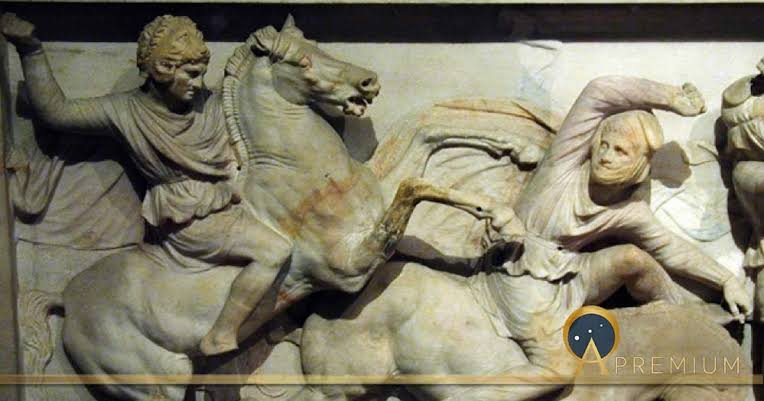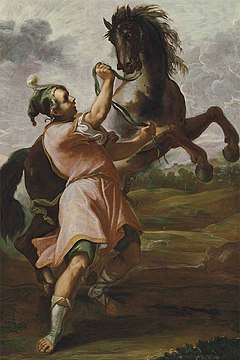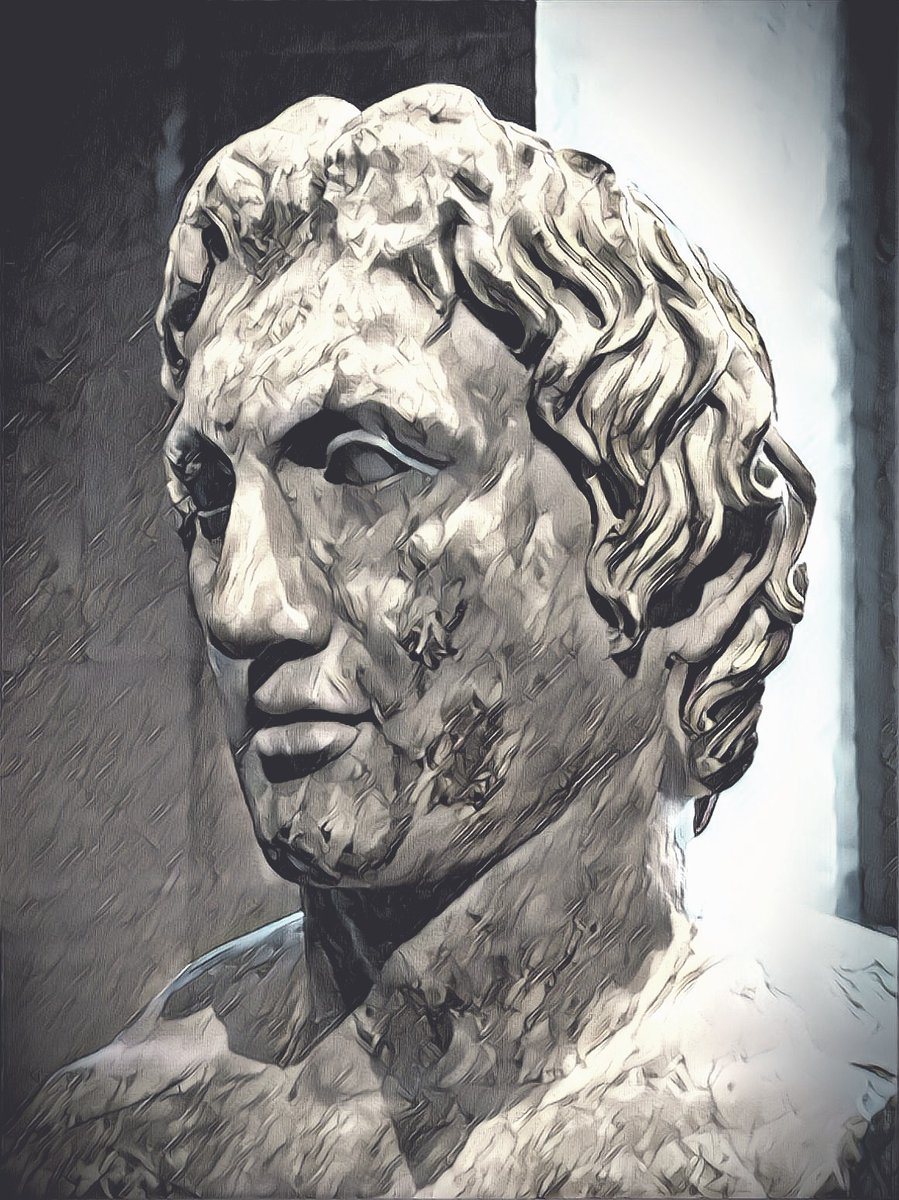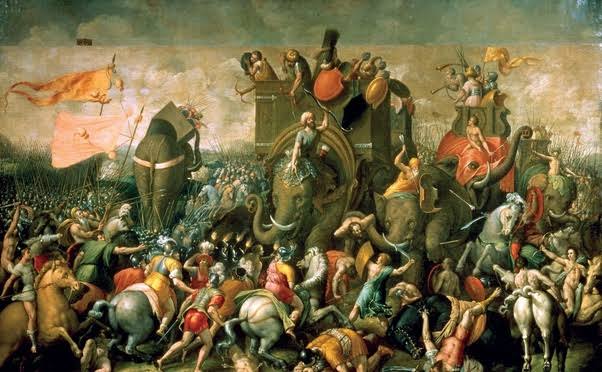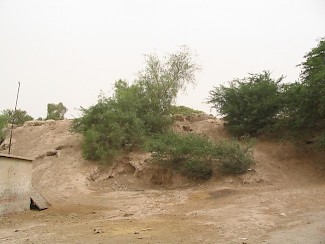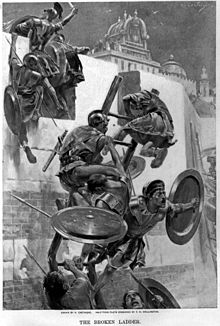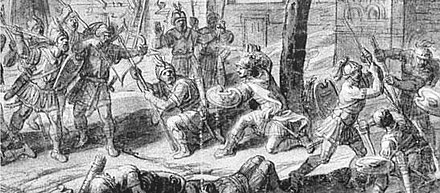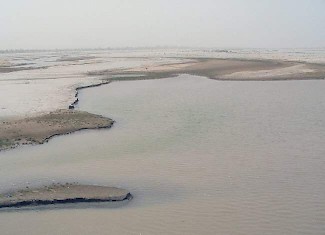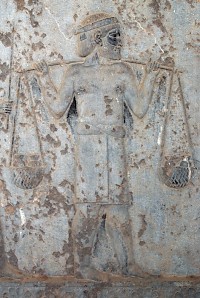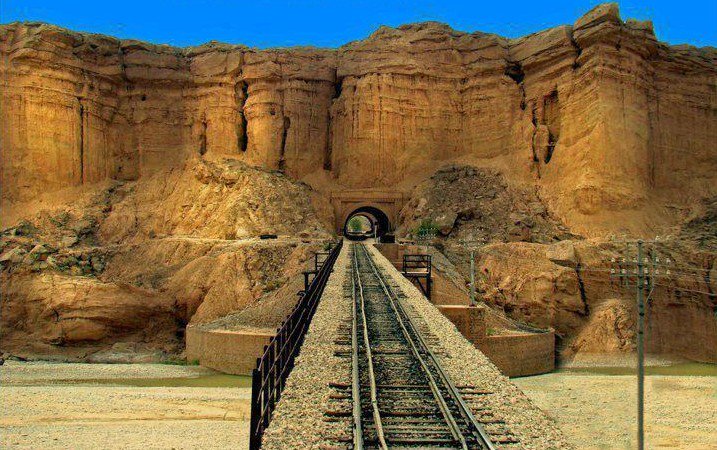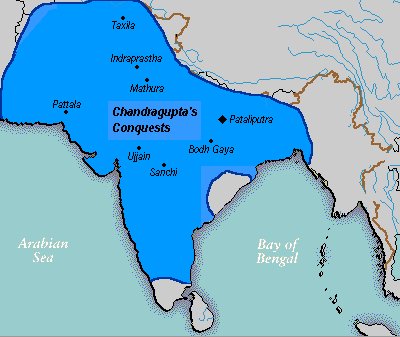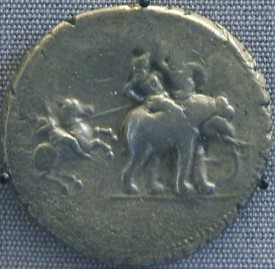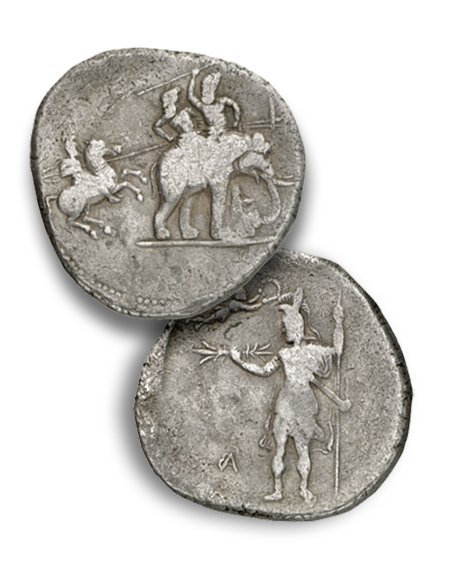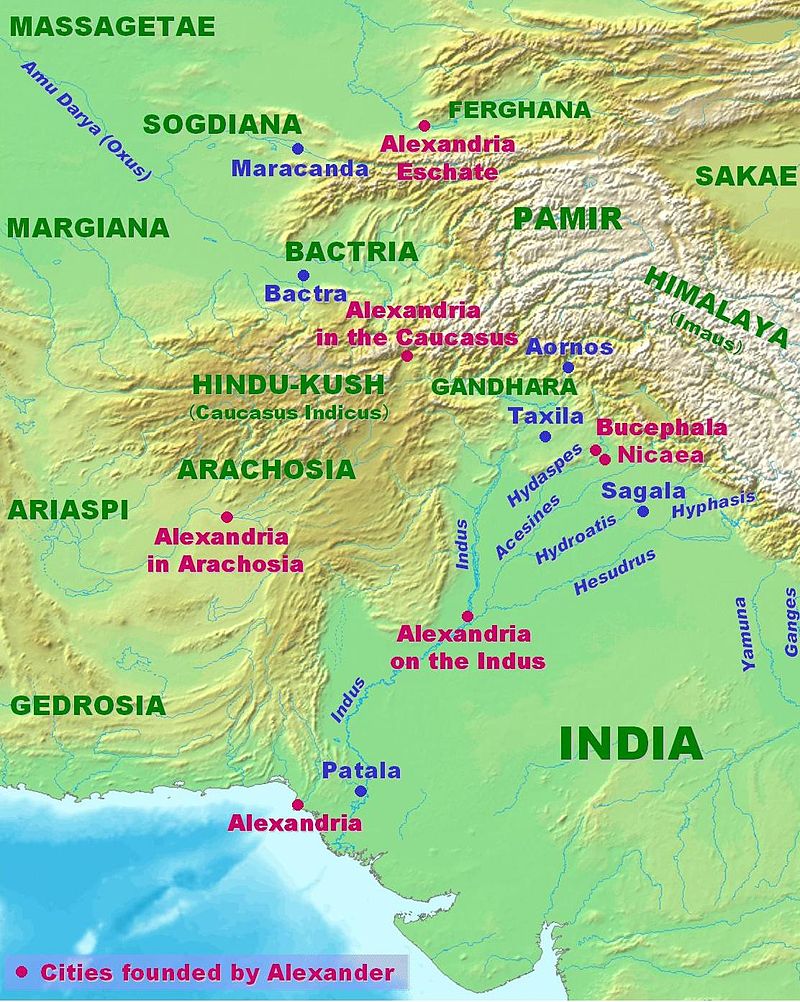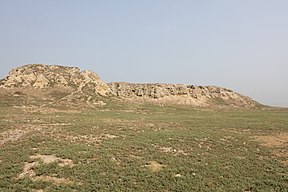Invasion of India by Alexander the Great: Part 2
This is the concluding part of the thread on Alexander& #39;s Invasion of India between 327 - 325 BCE.
This is the concluding part of the thread on Alexander& #39;s Invasion of India between 327 - 325 BCE.
After his victory, Alexander performed sacrifices & found two cities at the site of the battle.
1) Bucephala, named after his horse which died during the battle, probable location is Jalalpur- Sharif, Pakistan, &
2) Niceaea, named after the goddess of victory, in Mong, Pakistan
1) Bucephala, named after his horse which died during the battle, probable location is Jalalpur- Sharif, Pakistan, &
2) Niceaea, named after the goddess of victory, in Mong, Pakistan
Bucephala grew into an important site for trading and was still there in existence in the Roman era.
Bucephalaus was the favourite horse of Alexander, who was with him since childhood. It was perhaps 17 years old at the time of its death.
Image of Alexander taming Bucephalaus.
Bucephalaus was the favourite horse of Alexander, who was with him since childhood. It was perhaps 17 years old at the time of its death.
Image of Alexander taming Bucephalaus.
After this, Alexander conquered a tribe called & #39;Glausai& #39; situated between the rivers Jhelum (Hydaspes) and Chenab (Akesines).
He invaded the Glausai with half of his companions, infantry, archers & Agrinanians.
37 cities of Glausai surrendered to him after a short fight.
He invaded the Glausai with half of his companions, infantry, archers & Agrinanians.
37 cities of Glausai surrendered to him after a short fight.
Alexander then crossed Akesines river ( Chenab).
It was brought to his notice here that a relative of Poros, also named Poros by the Greeks had not yet surrendered to him.
Alexander pushed towards his kingdom. However, this Poros ran away on seeing the approach of Greek arms.
It was brought to his notice here that a relative of Poros, also named Poros by the Greeks had not yet surrendered to him.
Alexander pushed towards his kingdom. However, this Poros ran away on seeing the approach of Greek arms.
Next target of Alexander was the Kaithans& #39; or the region of & #39;Madra& #39;.
The Kaithans were the most warlike people in the area and were situated near the area of Sialkot in modern Pakistan.
Their capital was called Sangla, which is perhaps the original name of Sialkot.
The Kaithans were the most warlike people in the area and were situated near the area of Sialkot in modern Pakistan.
Their capital was called Sangla, which is perhaps the original name of Sialkot.
In order to invade them, Alexander crossed the river Hydraotes ( Ravi) and infested their cities.
It proved to be a tough fight as the Kaithians were unwilling to surrender their cities and fought till death.
Their casualties alone amounted to 17,000 killed & 70,000 captives.
It proved to be a tough fight as the Kaithians were unwilling to surrender their cities and fought till death.
Their casualties alone amounted to 17,000 killed & 70,000 captives.
An angry Alexander, due to losses suffered by him, razed the capital of Kaithans, Sangla to the ground.
He than moved forward and crossed the Beas river. However, this is where his campaign to conquer the world ended.
He than moved forward and crossed the Beas river. However, this is where his campaign to conquer the world ended.
At Beas Alexander, heard about the riches of Prachya ( Eastern region) and Gangradei (people living near Ganges valley).
The region was also very powerful with thousands of elephants in their army.
These reports filled the hearts of his soldiers with apprehension.
The region was also very powerful with thousands of elephants in their army.
These reports filled the hearts of his soldiers with apprehension.
They were actually the Nanda empire based at Pataliputra. Their army strength is calculated to be 200,000 infantry, 3,000 elephants, 20,000 cavalry & 2,000 four- horsed chariots.
Contrary to the feelings of his soldiers, he resolved to make himself a master of these regions.
Contrary to the feelings of his soldiers, he resolved to make himself a master of these regions.
But as he found about the apprehension of his soldiers, he gave them a speech motivating them asking them for one final campaign for his sake.
After Alexander had finished, Coenus, his general spoke for the soldiers and pointed out that & #39;many have perished through disease& #39;.
After Alexander had finished, Coenus, his general spoke for the soldiers and pointed out that & #39;many have perished through disease& #39;.
He also suggested Alexander to return back through the sea as his soldiers were tired and would be unwilling to go with him.
An angry Alexander, hearing this, shut himself up in his tent for three days, but his soldiers did not budge.
An angry Alexander, hearing this, shut himself up in his tent for three days, but his soldiers did not budge.
In the end, Alexander had to bow down before the wishes of his army.
Before going back, Alexander constructed 12 altars dedicated to Olympian gods and thus, marking his victories in the east.
The exact spot of these altars still remain unidentified.
Before going back, Alexander constructed 12 altars dedicated to Olympian gods and thus, marking his victories in the east.
The exact spot of these altars still remain unidentified.
On his way back, Alexander conquered the Aglassoi, who lived near the lower Indus valley.
Aglassoi had an army of 40,000 foot and 3,000 cavalry.
Aglassoi had an army of 40,000 foot and 3,000 cavalry.
In one of their towns, the citizens numbering about 20,000 cast themselves into flames , along with their wives & children, rather than submitting as prisoners to the enemy.
Perhaps, this is the first instance of & #39;Jauhar& #39; in Indian history !
Perhaps, this is the first instance of & #39;Jauhar& #39; in Indian history !
Moving towards Jhelum, Alexander constructed boats and ships numbering about 800 to sail down the Indus & reach the sea.
He knew that many kingdoms namely Mallavas (Malloi) and Kshudrakas ( Oxydracae) on that part of the Indus remained unconquered.
It was November 326 BCE.
He knew that many kingdoms namely Mallavas (Malloi) and Kshudrakas ( Oxydracae) on that part of the Indus remained unconquered.
It was November 326 BCE.
The Mallavas & Kshudrakas formed a coalition to oppose Alexander.
Such a federal army was known even in the days of Panini (500 BCE) who calls it & #39; the Kshudraka - Malavi - Sena& #39;.
Their allied strength was made up of 90,000 foot, 10,000 cavalry and above 900 chariots.
Such a federal army was known even in the days of Panini (500 BCE) who calls it & #39; the Kshudraka - Malavi - Sena& #39;.
Their allied strength was made up of 90,000 foot, 10,000 cavalry and above 900 chariots.
The Mallavas, based near modern Multan offered stiff resistance to Alexander, who commanded the main force, the Companion cavalry, the Dahan mounted archers and a part of the phalanx.
Several Mallian towns were attacked and captured.
Image of the old walls of Multan.
Several Mallian towns were attacked and captured.
Image of the old walls of Multan.
During the siege of the capital city of Mallavas, Alexander was seriously wounded by an arrow and was only saved by his bodyguard named Leonnatus, who protected him with the sacred shield of Troy.
Images of Alexander fighting at the Mallavas citadel.
Images of Alexander fighting at the Mallavas citadel.
The condition of Alexander was very serious and it was rumored that he had died.
However Alexander survived, but for the rest of his life, the son of Zeus Ammon was to suffer pain, because the arrow had penetrated his lung.
However Alexander survived, but for the rest of his life, the son of Zeus Ammon was to suffer pain, because the arrow had penetrated his lung.
The Macedonians were so enraged with the serious injury to Alexander that they killed most of the people in the Mallian capital. Even children, old, & women were not spared.
Mallians surrendered & gifted Alexander 300 four horse chariots, 1,000 shields & 100 talents of silver.
Mallians surrendered & gifted Alexander 300 four horse chariots, 1,000 shields & 100 talents of silver.
The Kshudrakas - allies of Malloi surrendered too.
They could not move fast enough and join their brethren in undertaking the defence of their country.
They could not move fast enough and join their brethren in undertaking the defence of their country.
Next, King Musicanus ( = Sanskrit Mushika), failed to pay homage to Alexander, giving Alexander an excuse to invade his territories.
Musicanus surrendered his capital, modern Alor to Alexander. Alexander forgave him and gave his kingdom back.
Image of Chenab River.
Musicanus surrendered his capital, modern Alor to Alexander. Alexander forgave him and gave his kingdom back.
Image of Chenab River.
Moving south, Alexander invaded the territory of King Sambus ( Sambu), with his capital at Sindimana or modern Sehwan.
King Sambus ran away, the Macedonian soldiers killed all males in his capital and captured women and children.
Image of an inhabitant of Indus Valley
King Sambus ran away, the Macedonian soldiers killed all males in his capital and captured women and children.
Image of an inhabitant of Indus Valley
Alexander reached the sea in April 325 BCE. Here, he got the news that that King Musicanus of Alor had revolted.
Alexander send Peithon with a small part of his army. Musicanus was captured & crucified, his capital was put to torch & thousands of Brahmins were hung from trees.
Alexander send Peithon with a small part of his army. Musicanus was captured & crucified, his capital was put to torch & thousands of Brahmins were hung from trees.
In the campaigns of lower Indus, the number of killed alone
amounted to 80,000.
In this region, it was the Brahmins who took part the lead & created the spirit of resistance & cheerfully sacrificed their lives in defence of their dharma.
This campaign was more of a genocide.
amounted to 80,000.
In this region, it was the Brahmins who took part the lead & created the spirit of resistance & cheerfully sacrificed their lives in defence of their dharma.
This campaign was more of a genocide.
On reaching the sea, Alexander divided his army into three divisions.
One division led by Nearchus, was sent on ships towards Susa, the main body led by Alexander left India through Gedrosian desert ( Baluchistan), and Craterus retreated via Bolan pass.
Images of Bolan Pass.
One division led by Nearchus, was sent on ships towards Susa, the main body led by Alexander left India through Gedrosian desert ( Baluchistan), and Craterus retreated via Bolan pass.
Images of Bolan Pass.
Alexander stayed in India for almost two years ( May 327 to April 325 BCE).
He conquered parts of modern day Pakistan from Swat to Indus valley.
His conquests were temporary, as he died without issue, in 323 BCE & his empire was divided by his successors called the & #39; Diadochi& #39;.
He conquered parts of modern day Pakistan from Swat to Indus valley.
His conquests were temporary, as he died without issue, in 323 BCE & his empire was divided by his successors called the & #39; Diadochi& #39;.
Causes of Defeat of Indian Kingdoms
Now we come to an important part as to why the Indian kingdoms, in- spite of their bravery & valour were defeated.
The armies of Indian states which fought Alexander were recruited from small republican states.
Now we come to an important part as to why the Indian kingdoms, in- spite of their bravery & valour were defeated.
The armies of Indian states which fought Alexander were recruited from small republican states.
The number of the army was very large in proportion to the number of the total population of the State concerned.
These states must have fought to a man & mobilised their entire man power in defence of their freedom in a sheer spirit of patriotism.
These states must have fought to a man & mobilised their entire man power in defence of their freedom in a sheer spirit of patriotism.
Even their women fought with the men, for e.g in the town of Massaga where Queen Cleophis & the womenfolk of her kingdom resisted Alexander.
Also, when Alexander massacred the mercenaries of Massaga, their women resisted enemy soldiers in hand-to-hand combat.
Also, when Alexander massacred the mercenaries of Massaga, their women resisted enemy soldiers in hand-to-hand combat.
If their heroic fight in the defence of their liberties against a supreme military leader like Alexander had failed for the time being, it was because it lacked leadership, organization, unity of direction & pooling of resources.
The defence was far too localised & isolated.
The defence was far too localised & isolated.
The defence was not organised into a national defence.
Alexander was thus, able to deal with the defence piecemeal, to proceed against each state separately, and to subdue it easily.
Alexander was thus, able to deal with the defence piecemeal, to proceed against each state separately, and to subdue it easily.
The municipality of States prevented a united front against a common enemy & caused the collapse of opposition at individual and isolated centres.
Division was fatal to defence.
Division was fatal to defence.
Soon, however, these defects & deficiencies of the Indian military situation were removed by a great leader like Chandragupta Maurya with his superior power of organization.
Problems faced by Alexander during his Conquest:
From the very beginning, the course of Alexander& #39;s invasion did not run smooth. It appeared to be smooth only on surface. Its difficulties lay deeper.
Alexander was not sure of his rear.
From the very beginning, the course of Alexander& #39;s invasion did not run smooth. It appeared to be smooth only on surface. Its difficulties lay deeper.
Alexander was not sure of his rear.
It was threatened by rebellions both among Greeks & Indians.
The prospects of his enterprise did not appeal as to his followers as to him personally.
Alexander& #39;s policy was to plant colonies of Greek veterans at new eastern cities, to mark the progress of his conquests.
The prospects of his enterprise did not appeal as to his followers as to him personally.
Alexander& #39;s policy was to plant colonies of Greek veterans at new eastern cities, to mark the progress of his conquests.
Such colonies were set up first in Bactria and Sogdia, but it was against the will of colonists who were not reconciled to this exile.
They were always longing for opportunity to desert.
They were always longing for opportunity to desert.
When Alexander was fighting with the distant Malloi & received a wound, a rumor of his death spread far and wide, & at once these Greek colonists numbering 3,000 left for home.
Alexander himself thought of these colonies as penal settlements for stifling out the opposition.
Alexander himself thought of these colonies as penal settlements for stifling out the opposition.
Nor the attitude of Indians, who were subdued were favourable. Their spirit of revolt was not subdued.
The administrative arrangements which Alexander made to secure his conquests betrayed his own sense of their insecurity.
The administrative arrangements which Alexander made to secure his conquests betrayed his own sense of their insecurity.
He divided Greek India in to 6 satrapies, 3 western satrapies were Greeks, but the 3 eastern satrapies were all Indians.
Of the 3 western satrapies, Peithon was posted as governor of Sindh, Nicanor was posted in charge of the province called & #39; India-west-of-Indus& #39;.
Of the 3 western satrapies, Peithon was posted as governor of Sindh, Nicanor was posted in charge of the province called & #39; India-west-of-Indus& #39;.
India-west-of-Indus& #39; comprised of Kabul valley & the hill tracts up to Hindu-Kush, with its capital at Pushkalavati ( modern Charassada, Pakistan).
Higher up, Alexander& #39;s father-in-law, Oxyartes was appointed governor of Paropansidae ( Kabul).
Image of remains of Pushkalavati
Higher up, Alexander& #39;s father-in-law, Oxyartes was appointed governor of Paropansidae ( Kabul).
Image of remains of Pushkalavati
Alexander could not venture to post Greek governors to the east of Indus.
Here, the three satraps were placed under Indian kings: Ambhi, king of Taxila, ruling from Indus to Hydaspes, Poros ruling from Hydaspes to Hyphasis (Beas) & King of Kashmir ruling over the remainder.
Here, the three satraps were placed under Indian kings: Ambhi, king of Taxila, ruling from Indus to Hydaspes, Poros ruling from Hydaspes to Hyphasis (Beas) & King of Kashmir ruling over the remainder.
The position of these Greek governors west of Indus, became rather precarious.
First Kandahar (Archosia ), raised the flag of rebellion at the instigation of an Indian chief, who the Greeks called Samaxus or Damaraxus.
Next, the Asvanayas, killed their governor named Nicanor.
First Kandahar (Archosia ), raised the flag of rebellion at the instigation of an Indian chief, who the Greeks called Samaxus or Damaraxus.
Next, the Asvanayas, killed their governor named Nicanor.
The Asvaknayanas also rebelled & made the position of their Greek governor very unsafe.
An Indian traitor named Sisikottus or Sasigupta, the agent of Greek imperialism quashed this rebellion. Alexander sent him help, & so did Philip from Taxila.
An Indian traitor named Sisikottus or Sasigupta, the agent of Greek imperialism quashed this rebellion. Alexander sent him help, & so did Philip from Taxila.
All this trouble was brewing in 326 BCE when Alexander was busy fighting in the thick of his campaigns.
His supply of men was falling as he was advancing farther & farther, and thus, he was strecting his supply lines further.
His supply of men was falling as he was advancing farther & farther, and thus, he was strecting his supply lines further.
His progress was brought to a standstill on the banks of Chenab till the situation was saved by the arrival of Thracian reinforcements from distant Iran.
But the Beas proved the limit of his advance. It was because the limit of endurance was reached by his followers.
But the Beas proved the limit of his advance. It was because the limit of endurance was reached by his followers.

 Read on Twitter
Read on Twitter